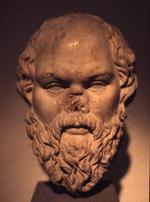Dēmos · Classical Athenian Democracy · a Stoa Publication
[ link colors: Demos | External Source | Citation to Evidence| Word Tools ]
Amy C. Smith, edition of January 18 2003
page 12 of 14
 (philosopher/teacher,
(philosopher/teacher,
Read about the evidence
Diogenes Laertius (Diog. Laert.).
Plot on a Map
Athens.
Naples.
Evidence: Only one statue of Socrates is mentioned in ancient literature. Diogenes Laertius (Diog. Laert. 2.43) explains that
the Athenians immediately felt remorse for having condemned Socrates to death, so that they honored him with a
bronze statue, created by Lysippos, that was placed in the Pompeion. But Lysippos’ career was much later than the death of Socrates so this work could not have been erected
immediately after Socrates’ death, as Diogenes suggests; this statue might have dated more
realistically to the
Two painted portraits of Socrates are noted by ancient writers: Lucian, in the Death of Peregrinus 38, mentions that several painters treated the subject of Socrates dying among his disciples; and Joannes Barboukallos mentions a painted portrait of Socrates in an epigram (Grk. Anth. 16, no. 327).
Read about the evidence
Plato (Plat. Sym.).
Cicero (Cic. de Fato).
Xenophon (Xen. Sym.).
Ancient sources, both written and visual, provide a consistent view of Socrates’ physical form. His appearance was often compared to that of a Silenos, with regard to his stocky, broad-shouldered body (Plat. Symp. 215a ff.; Xen. Symp. 5.7), thick neck (Cic. De Fato ch. 5), protruding belly (Xen. Symp. 2.19), baldness (Sidon. Apoll. Epist. 9.9.14; Lucian, Dialog. mortuorem 20, Menippi et Aeaci 417), prominent eyeballs (Xen. Symp. 5.7), broad nose with wide nostrils and large mouth with thick lips (Xen. Symp. 5.7).
Extant portraits:
Plot on a Map
Baalbek.
Ephesos.
Athens.
Naples.
-
Type A:
- Naples 6129: a marble bust.
-
Type B:
Plot on a Map
Baalbek.
Ephesos.
Athens.
Naples.-
Heads or herms in the round:
- Naples 6415: an inscribed marble herm.
- Terme 1236: a marble head.
- Boston 60.45: a small marble head, perhaps from a herm (shown here).
- Louvre MA 59: a marble head (image).
- Vatican ?: inscribed marble herm labelled
ΣΩΚΡΑΤΗΣ (image).
-
Figures in the round:
- Copenhagen, NCG 415C: (image).
- London ?: a marble statuette.
-
Mosaics and paintings:
Plot on a Map
Baalbek.
Ephesos.- Mosaic from Baalbek (now in the Beyrough Museum): mosaic
medallion with a bald, bearded figure, inscribed
ΣΩΚΡΑΤΗΣ , among the seven sages (see Richter 1965, 118, fig. 571). - Painting at Ephesos (
1 c. A.C. ): painting found in1963 in a Roman house at Ephesos with a seated figure inscribedΣΩΚΡΑΤΗΣ (see Richter 1965, 119, fig. 563a).
- Mosaic from Baalbek (now in the Beyrough Museum): mosaic
medallion with a bald, bearded figure, inscribed
-
Gems and coins:
- Roman gemstones, e.g. a carnelian in Athens, inscribed
ΣΩΚΡΑΤΗΣ (see Richter 1965, 119, fig. 570). - Bronze contorniate, inscribed
ΣΩΚΡΑΤΗΣ , in Naples (once in the collection of Fulvius Ursinus).
- Roman gemstones, e.g. a carnelian in Athens, inscribed
-
Other variants:
Plot on a Map
Pompeii.
Apamea.
Cologne.
- Naples 6128: Bronze relief of Socrates and Diotima, from Pompeii (perhaps a combination of types A and B).
- Mosaic from Apamea: mosaic with a bald, bearded figure,
inscribed
ΣΩΚΡΑΤΗΣ , among the seven sages (see Richter 1965, 118, fig. 569). - Mosaic from Cologne (now in the Römisch-Germanisches Museum, Cologne): mosaic with a figure inscribed
ΣΩΚΡΑΤΗΣ (see Richter 1965, 118, fig. 572).
page 12 of 14
